
“Silently, one by one, in the infinite meadows of heaven,I was recently on a camping trip in the mountains of Colorado, and one of the highlights was definitely being able to lay on a picnic table and try to find constellations without the intrusive lights of my home in Denver. While I could easily pick out a few of the better known constellations, I was disappointed that I couldn’t point out more, and that I couldn’t remember a darn thing from elementary school about the myths behind the stars.
Blossomed the lovely stars, the forget-me-nots of the angels.”
― Henry Wadsworth Longfellow, Evangeline: A Tale of Acadie
My ancient forbearers knew the night sky like the back of their hand. The constellations oriented them in a literal sense – as vital navigation tools – but in a spiritual one as well, serving as vivid reminders of their mythologies and place in the universe. Still today, knowing the constellations can be a source of both satisfying knowledge and humbling awe.
So in this post, I’m going to give you a crash course in the Greek mythology of the most prominent constellations, as well as some tips for finding and identifying them. I use Greek mythology because it was Ptolemy in the 2nd century who identified and listed 48 constellations. This was the first written and scientific account of the constellations, and although his notes only covered the sky that he could see, it was used for centuries as the benchmark for astronomy. It should be noted that many of the constellations listed also have Babylonian, Egyptian, Roman mythologies, and more. What’s interesting is that while the specific characters in the stories may change, the rough outlines and shapes of the constellations remained fairly similar.
The International Astronomical Union lists 88 constellations — a list that has been in use since 1922 and encompasses all the night sky around the world. I chose the 15 below based on a combination of size, visibility, importance of stars within them, ease of recognition, and place in folklore through history.
How to Find Constellations in the Night Sky

This is what a star map looks like (this is from Starmap). You orient it just like a map, and then look up to find those constellations!
Other than a star map, all you need is a dark sky (as far away from cities as possible), and for extra visual aide, a pair of binoculars or a telescope. With the naked eye, you’ll see basic outlines, but with binoculars or a telescope you’ll see fainter stars and other features like nebulae and star clusters. When you’re out observing, you’ll want to generally orient yourself towards the North Star (directions on how to find the North Star are found at the bottom of the article).
While below I note a “best viewed” month for each constellation, many are visible for at least 6 months of the year – just not quite as vividly. The constellations below are the most famous and most visible to the naked eye in the Northern Hemisphere.
Aquarius

This
drawing, as well as those below, is from Sidney Hall’s set of drawings
called Urania’s Mirror. Published in 1824, the set contains 32 star
chart cards depicting 79 constellations, many of which are no longer
recognized or are considered sub-constellations. The illustrations are
based on what’s viewable from Great Britain, making them fairly similar
to what you’d see in the States.
Best viewed in: October
While one of the biggest, most famous, and oldest named constellations, Aquarius is faint and often hard to find/see. In Greek mythology, Aquarius represented Ganymede, a very handsome young man. Zeus recognized the lad’s good looks, and invited Ganymede to Mt. Olympus to be the cupbearer of the gods. For his service he was granted eternal youth, as well as a place in the night sky.
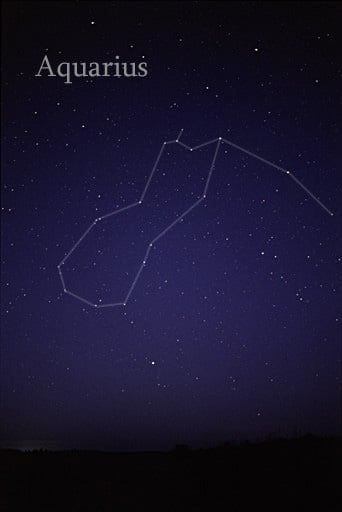
Despite its prominent position and large size, you can see that Aquarius doesn’t really have defining features, nor does it contain any bright stars. The protruding line to the right is Aquarius’s right arm, with the large downward shape being a combination of the water flowing down out of the vase and his right leg. While not the entire constellation, what’s drawn above is what you’re most likely to see in the night sky. You won’t see this one in the city; you’ll need a dark sky to find the cupbearer.
Aquila
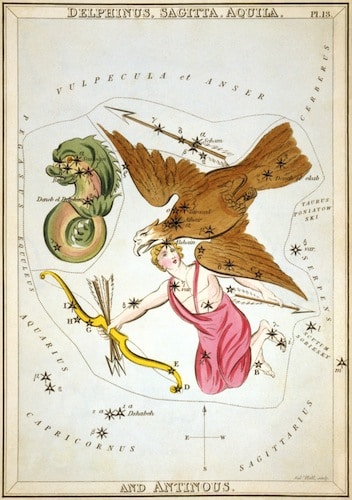
Delphinus,
on the left, is still a recognized constellation, but quite small and
faint. Sagitta, the bow and arrow, is considered an ancient
constellation.
Best viewed in: late summer, September
Aquila was the eagle that in Greek mythology actually bore Ganymede (Aquarius) up to Mt. Olympus. The eagle was also the thunderbolt carrier for Zeus.

This constellation lies in the Milky Way band, and its most prominent star is Altair, which is actually one of the closest naked eye stars to the earth. The top portion of Aquila forms a shallow inverted “V,” with Altair nearly the point. This represents the head and wings of the eagle. A line then descends from Altair, which forms the body of the eagle.
Look towards the southern sky in the late summer, near the Milky Way band, for Aquila.
Aries
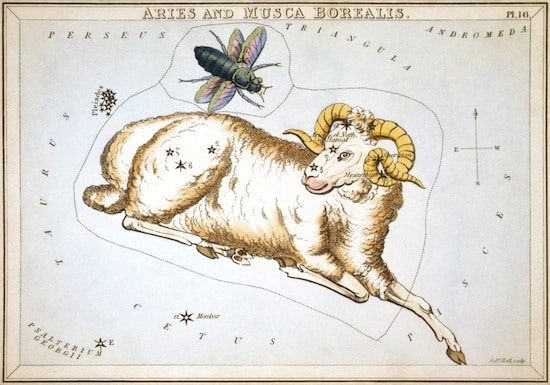
Musca Borealis, the bee, is a discarded constellation.
Best viewed in: December
While many constellations have gone through various iterations of mythological stories, Aries has always been the ram. This constellation is one of 12 constellations that form the zodiac — the constellations that straddle the sun’s path across the sky (known in scienctific terms as the ecliptic). In ancient times, that gave the constellations of the zodiac special significance.
In Greek mythology, Aries is the ram whose fleece became the Golden Fleece. The Golden Fleece is a symbol of kingship and authority, and plays a significant role in the tale of Jason and the Argonauts. Jason is sent to find the fleece in order to rightfully claim his throne as king, and with some help from Medea (his future wife), finds his prize. It’s one of the oldest stories in antiquity, and was current in Homer’s time.

Aries is formed by just 4 (sometimes 5) visible stars, which create a line from the ram’s head (the lowest point in the image above) and down its back. Hamal is the largest and most visible star, and is classified as an orange giant.
Canis Major

Lepus,
the hare, while listed in Ptolemy’s original 48 constellations, does
not represent any Greek myth. While not featured in this list, Lepus can
be found right underneath Orion.
Best viewed in: February
Canis Major represents the famed Greek dog Laelaps. There are a few origin stories, but the common theme is that he was so fast he was elevated to the skies by Zeus. Laelaps is also considered to be one of Orion’s hunting dogs, trailing behind him in the night sky in pursuit of Taurus the bull.

Canis Major is notable because it contains the brightest star in the night sky, Sirius. Tradition notes that the first appearance of Canis Major in the dawn sky comes in late summer, ushering in the dog days of the season. In the night sky, it almost looks a stick figure, with Sirius at the head, and another bright star, Adhara, at its rear end.
Cassiopeia
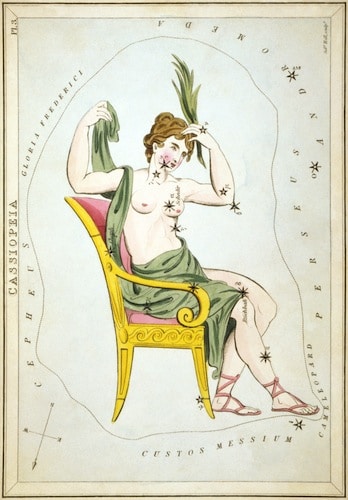
No Latin meaning, it’s the name of a queen in Greek mythology
Best viewed in: November
Cassiopeia, in Greek mythology, was a vain queen who often boasted about her beauty. She was the mother of Princess Andromeda, and in contrast to other figures being placed in the sky in honor, Cassiopeia was forced to the heavenly realms as punishment. As the story goes, she boasted that her beauty (or her daughter’s, depending on the story) was greater than that of the sea nymphs. This was quite an offense, and she was banned to the sky for all to gawk at.
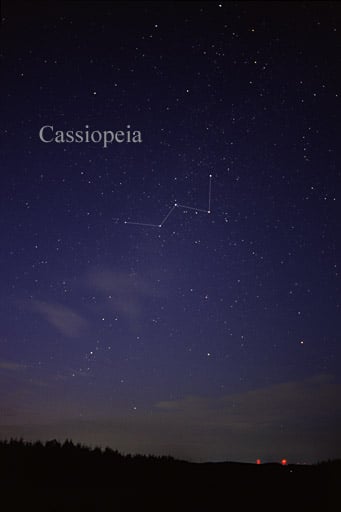
With its distinctive “W” shape formed by five bright stars, Cassiopeia is one of the most easily recognizable constellations in the night sky come fall and early winter. And because of that, the vain queen is one of the most oft-mentioned in pop culture and one of the earliest constellations that young children come to recognize in the sky.
Cygnus (also known as the Northern Cross)

Lacerta
(the lizard) and Vulpecula (the fox) are faint constellations near
Cygnus the swan and Lyra. Both weren’t classified as constellations
until the 17th century.
Best viewed in: September
Multiple personas take on the form of the swan in Greek mythology. At one point Zeus morphed into a swan to seduce Leda, mother of both Gemini and Helen of Troy. Another tale says that Orpheus was murdered and then placed into the sky as a swan next to his lyre (the constellation Lyra, also in the drawing above).
The constellation may also have gotten its name from the tale of Phaethon and Cycnus. Phaethon was the son of Helios (the sun god), and took his father’s sun chariot for a ride one day. Phaethon couldn’t control the reins, however, and Zeus had to shoot down the chariot with Phaethon in it, killing him. Phaethon’s brother, Cycnus (now spelled Cygnus), spent many days grieving and collecting the bones, which so touched the gods that they turned him into a swan and gave him a place in the sky.
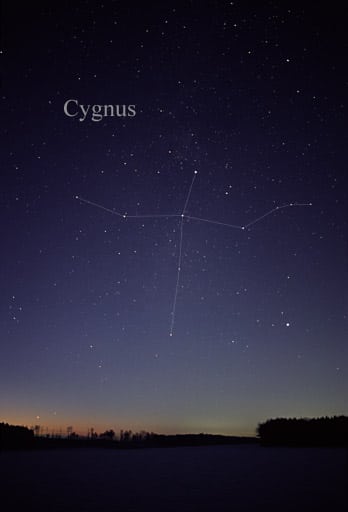
The Northern Cross is really just an asterism (recognizable pattern of stars) within Cygnus the swan. Deneb, the swan’s tail (or top point of the cross), is one of the brightest stars in the night sky. You’ll find Cygnus within the Milky Way, which is why you’ll sometimes see the constellation referred to as the backbone of the galaxy. In the night sky, the goose is looking down with its wings spread out parallel to the horizon.
Gemini
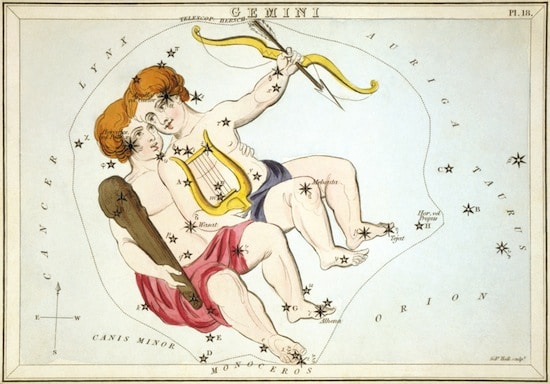
Latin for “twins”
Best viewed in: February
Gemini represents the twins Castor and Pollux. While the twins’ mother was Leda, Castor’s father was the mortal king of Sparta, while Pollux’s father was King Zeus (He seduced Leda in the form of a swan, remember? These stories tend to all tie together!). When Castor was killed, the immortal Pollux begged Zeus to give Castor immortality, which he did by placing the brothers in the night sky for all time.

Castor and Pollux also happen to be the names of the brightest stars in the constellation, and represent the heads of the twins. Each star then has a line forming their bodies, giving the constellation a rough “U” shape. The twins sit next to Orion, making them fairly easy to find in winter.
Leo
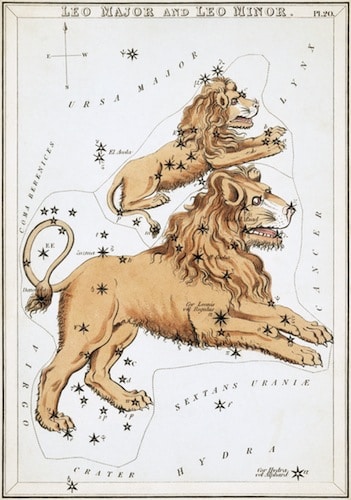
Leo
Minor is a recognized constellation, but is so small and faint that
Ptolemy didn’t include it in his original list. To this day, Leo Major
is solely regarded as “Leo.”
Best viewed in: April
Leo has been a great lion in the night sky across almost all mythological traditions. In Greek lore, Leo is the monstrous lion that was killed by Hercules as part of his twelve labors. The lion could not be killed by mortal weapons, as its fur was impervious to attack, and its claws sharper than any human sword. Eventually Hercules tracked him down and strangled the great beast, albeit losing a finger in the process.
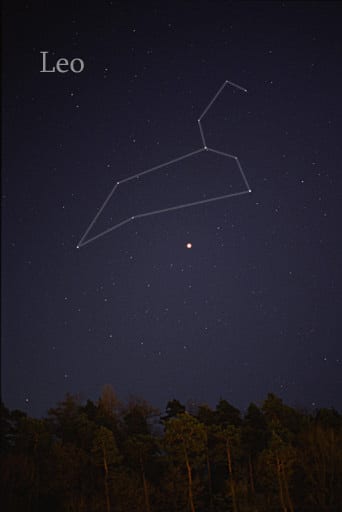
The large, orange “star” underneath Leo is actually the planet Jupiter.
Lyra

Latin for “lyre”
Best viewed in: August
Lyra is associated with the myth of Orpheus the great musician (remember him from earlier?). Orpheus was given the harp by Apollo, and it’s said that his music was more beautiful than that of any mortal man. His music could soothe anger and bring joy to weary hearts. Wandering the land in depression after his wife died, he was killed and his lyre (harp) was thrown into a river. Zeus sent an eagle to retrieve the lyre, and it was then placed in the night sky.

Lyra sort of forms a lopsided square with a tail to its brightest star, Vega, which is one of the brightest stars in the sky. It is small, and almost directly overhead in the summer months, but the bright Vega makes it fairly easy to find.
Orion
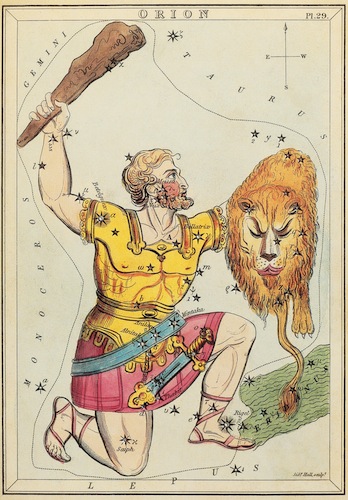
The lion’s head being held by Orion is also sometimes visualized as a shield.
Best viewed in: January
Orion is one of the largest and most recognizable of the constellations. It is viewable around the world, and has been mentioned by Homer, Virgil, and even the Bible, making it perhaps the most famous constellation.
Orion was a massive, supernaturally gifted hunter who was the son of Poseidon. It was said he regularly hunted with Artemis (Goddess of the Hunt) on the island of Crete, and that he was killed either by her bow, or by the sting of the great scorpion who later became the constellation Scorpius.

Orion’s belt of three stars is the easiest asterism to find, with Rigel (bottom right) and Betelgeuse (top left) being the brightest two individual stars. The two other corners form a rough quadrangle, with his head and bow also sometimes visible. Orion is also unique in that you can use him to find a variety of other constellations in the winter sky.
Pisces 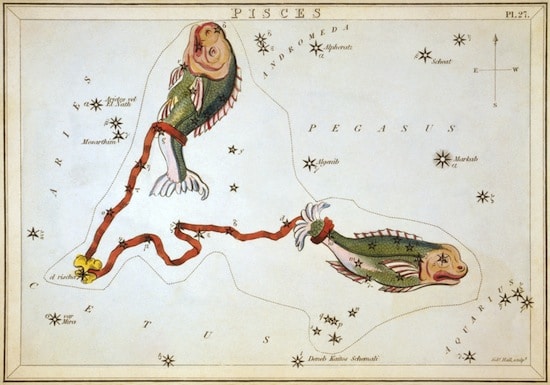
Latin for “fish” (plural)Best viewed in: November
The two fish of the sky represent Aphrodite and her son Eros, who turned themselves into fish and tied themselves together with rope in order to escape Typhon, the largest and most vile monster in all of Greek mythology.

It’s not likely you’ll find Pisces in the middle of a city, as none of its individual stars are really worth noting or particularly bright. It forms a large “V” with the right fish forming a small “O” on the end, and the left fish forming a small triangle on the end (the image above doesn’t connect the dots in the upper left to make it a triangle).
Scorpius

Scorpius is sometimes also known as just Scorpio.
Best viewed in: July
There are a variety of myths associated with the scorpion, almost all of them involving Orion the hunter. Orion once boasted that he could kill all the animals on the earth. He encountered the scorpion, and after a long, fierce fight, Orion was defeated. It was such a hard-fought battle that it caught the eye of Zeus, and the scorpion was raised to the night sky for all eternity.

With many bright stars, Scorpius is fairly easy to find in the night sky. Antares, the brightest star in the constellation, is said to be the heart of the scorpion. That will be the easiest star to locate, but is sometimes confused with Mars because of its red-orange coloring. To the right of the heart are 3-5 stars that form the head. To the left are a long line of stars that curve into a sideways or upside-down question mark.
Taurus
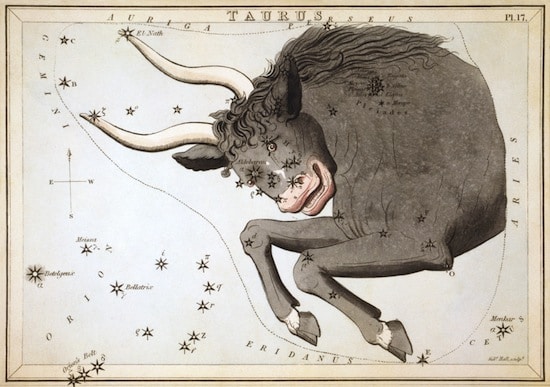
Latin for “bull”
Best viewed in: January
Taurus is a large and prominent fixture in the winter sky. As one of the oldest recognized constellations, it has mythologies dating back to the early Bronze Age. There are several Greek myths involving Taurus. Two of them include Zeus, who either disguised himself as a bull or disguised his mistress as a bull in multiple escapades of infidelity. Another myth has the bull being the 7th labor of Hercules after the beast wreaked havoc in the countryside.

The constellation is fairly easy to find as its most recognizable asterism forms a very prominent “V,” which represent the head and horns of the bull. The brightest star in the constellation is Aldebaran, which forms the bull’s right eye. Five stars, fairly close together to the naked eye, form an almost perfect small “V,” with the “V” extending up quite a ways to two more final stars that are the points of the horns.
Ursa Major

Latin for “larger bear”
Best viewed in: April
The Big Dipper is popularly thought of as a constellation itself, but is in fact an asterism within the constellation of Ursa Major. It is said to be the most universally recognized star pattern, partially because it’s always visible in the northern hemisphere. It has great significance in the mythologies of multiple cultures around the world.
The Greek myth of Ursa Major also tells the story of Ursa Minor (below). Zeus was smitten for a young nymph named Callisto. Hera, Zeus’s wife, was jealous, and transformed Callisto into a bear. While in animal form, Callisto encountered her son Arcas. Being the man that he was, he was inclined to shoot the bear, but Zeus wouldn’t let that happen, and so turned Arcas into a bear as well, and placed mother (Ursa Major) and son (Ursa Minor) permanently in the night sky.

The seven stars of the Big Dipper are easily recognized and almost always visible. They form part of the backside and tail of the large bear. While the rest of the bear definitely takes the shape of its namesake, it’s not often visible in light polluted areas. The Big Dipper is more than just a pretty shape; the outer edge of its “bowl” will always lead you to the North Star, aiding in navigation for centuries past. Simply make a line with the two stars of the Big Dipper’s outer edge, extend that line up into the sky, and at about five times the distance between the two stars you started with, you’ll find the North Star.
Ursa Minor

The
little bear sits almost enveloped by the huge Draco. While still a
modern constellation, Draco’s size is overshadowed by the importance of
Ursa Minor and the North Star.
Best viewed in: June
Ursa Minor is famous for containing Polaris, the North Star. Many people erroneously think that the North Star is directly over their heads, but that’s only true at the North Pole. For most people in the Northern Hemisphere, it will be dipped into the night sky.

You
can see the Big Dipper sitting prominently below Ursa Minor. This also
gives a great visualization of how to use the Big Dipper to find the
North Star.















